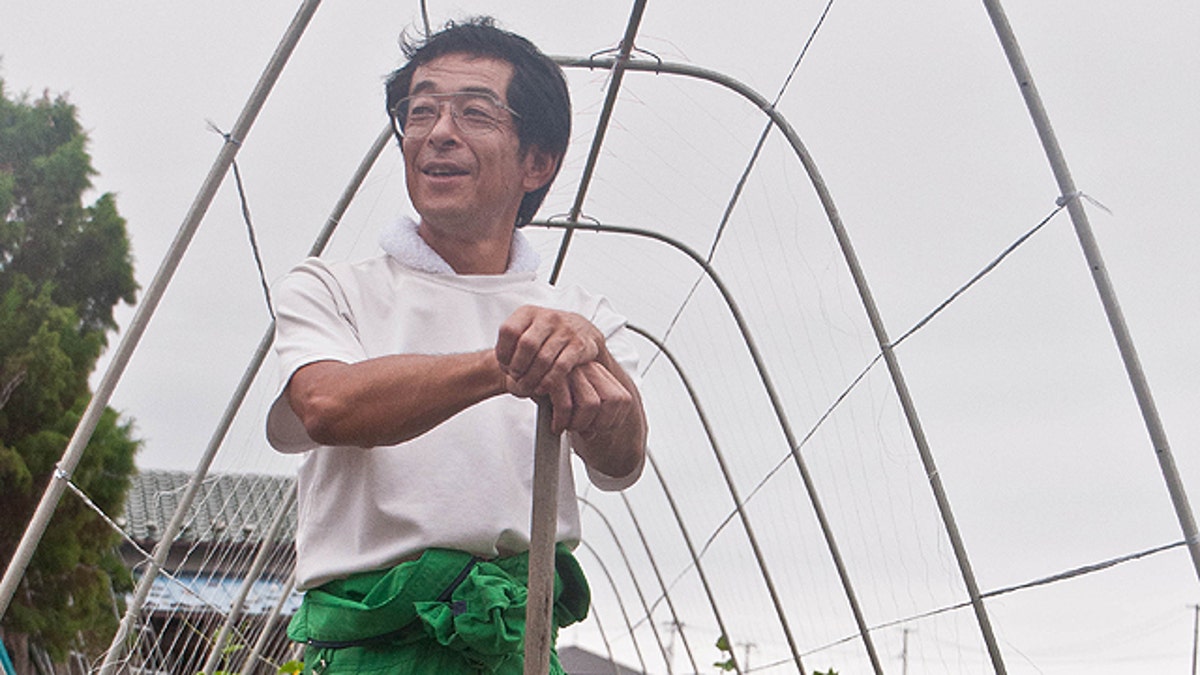
Like many local farmers who survived, Hirofumi Ouchi was told that if he left his land alone the government would fix it within a year, and provide insurance money. (Amanda Marshall/FoxNews.com)
SENDAI, Japan – In one of the hardest hit coastal areas in Sendai, Japan, Hirofumi Ouchi is rebuilding his farm.
"Over 100 of my neighbors died here, yet my family and I were allowed to live. So I need to keep exerting effort, to stand firm and persist to get this area back to how it was."
The March 11 earthquake and tsunami took over 20,000 lives, and destroyed entire towns, communities and livelihoods.
“Most of the farmers from here that survived are much older than me," Ouchi said. "Their machines are broken or gone and it’s hard for them to have the willpower to get going again. We face many challenges, so if someone doesn’t take the lead and show them that this can be done, the others won’t come back to this area.”
Like many local farmers who survived, Ouchi was told that if he left his land alone the government would fix it in a year, and provide insurance money. Reports concluded that the damaged soil would not bring production for at least one to three years, maybe even five.
“But I’m not going to sit around. I might as well do what I can on my own, so I began working,” he said.
Ouchi's ancestors began farming his land more than two hundred years ago, and with the help of many dedicated volunteers, his farm is producing again.
“Some of the leafy vegetables are still very salty from the state of the soil, but here we have lettuce, cabbage, broccoli and cucumbers," he said. "I am not a Christian but the Bible verse, ‘God will not give you more than you can bear,’ stays with me. So even with this tsunami, it isn’t something that we cannot overcome. As you can see, we’ve already come this far.”
Ouchi does not live far from Gamo -- an entire town that was ripped away by the strength of the tsunami. Minimal pieces of concrete home structures along with a single standing cross are all that remain in a once successful farming and local fishing community.
North and south of Gamo, roughly 200 miles of coastline were inundated. In the past six months, many wards have been cleared of debris and roads have been rebuilt. Though towns like Gamo and Higashi Matsushima north of Sendai, are unlivable and empty except for government demolition and cleanup crews and local and international relief group volunteers. Thousands of survivors in evacuation centers and temporary housing facilities are awaiting authorization to rebuild their homes or not.
"The Japanese government has been so efficient in this major disaster, but we may be facing the hardest challenges ahead of us," says Paul Nethercott, spokesman for CRASH Japan, a relief organization that’s been on the ground since the disaster struck. "You have thousands of people who lost not only their homes but also family members and jobs. The government can only go so far in providing means to rebuild. And we’re already finding suicides and PTSD."
The group has partnered with local Japanese churches and mobilized over 1,000 international volunteers. Nethercott says they intend to be fully engaged in the relief for at least two more years.
According to Chief Cabinet Secretary Osamu Fujimara, in many cases disposal operations have only reached primary stages.
“This is therefore still a matter relating to recovery,” he said in a September press conference. “Another issue concerns contaminated sludge, particularly sludge contaminated with radioactive materials and efforts to deal with this contaminated sludge have not proceeded in line with expectations. I believe that on the whole, instead of just stressing reconstruction, we should recognize that there are still areas where recovery efforts are insufficient.”
Radiation also remains a concern in the Fukushima Prefecture. The twenty kilometers around the Fukushima Daiichi Nuclear Power Plant is a restricted area sealed off to outsiders. According to Chief Cabinet Secretary Fujimura, 80,000 residents have also left the Fukushima Prefecture as a whole. The concern however, does not appear to be prevalent outside the affected area.
“Each of our operational camps along the coast and especially those closest to Fukushima independently and regularly have tested the radiation levels since the first days of the disaster," Nethercott said. "The levels have come back normal every time. We work closely with local Japanese churches and groups and no one has seen any irregularity in levels outside the first days on the ground.”
Despite the vast challenges over the past six months and those remaining ahead, survivors like Ouchi show a resiliency commonplace in the Tohuko disaster zones.
“We’re all trying to be normal again and get our lives back," Ouchi said. "My job is to grow vegetables and by doing so I can give back to everyone who has helped me and show other farmers that it can be done. That is my hope.”
